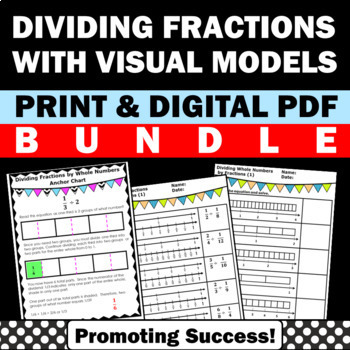5th Grade Math Curriculum Standards Dividing Fractions Early Finishers Stations
- Zip
- Internet Activities
- Easel Activity
What educators are saying
Products in this Bundle (5)
Description
You will download a bundle of 3 fraction worksheet packets for your 5th grade students to practice and review dividing fraction with number lines and picture models. You will receive fraction anchor charts, examples, word problems. and answer keys.
These fraction task cards align with Grade 5 Common Core math standards and will supplement your curriculum as an informal pre assessment, as an extra practice or review activity, or intervention work.
- Dividing Fractions by Fractions
- Dividing Whole Numbers by Fractions
- Dividing Fractions by Whole Numbers
This dividing fractions activity bundle will work well for your early finishers, morning work, bell ringers, review homework, station or center activities, formative assessments, independent work packet, emergency sub plans, and as extra practice for your ESL and special education students.
For your convenience, you will download both TPT digital EASEL and printable PDF resource formats.
☛ Please click on the PREVIEW above.
➥ Click HERE to go back to my storefront and browse the categories on the left.
▶︎ DIGITAL COMPATIBLE RESOURCE:
- Through the EASEL by TPT platform, you will be able to annotate and customize the PDF using overlays. Underlying content is not editable. You will then be able to assign chosen pages to your students.
▶︎ TERMS OF USE:
- Single classroom use only.
- Password protected classroom websites only, not to be found on Google search.
- No commercial use, including Outschool, etc. Contact me if you need a commercial use license.
- No reselling in any digital or print formats.
- Click HERE to see my most current terms of use.
⚙️ CUSTOMER TIPS:
- Click HERE to sign up for my newsletter with flash freebies, secret sales, and more!
- Click on the ★ above to follow my store. You will receive email notifications from TPT of newly listed products and freebies.
- Leave feedback to earn TpT credit points to save money on future products.
Thank you so much for all you are doing for kids!
❤️ Shelly Anton
Promoting Success for You and Your Students!





